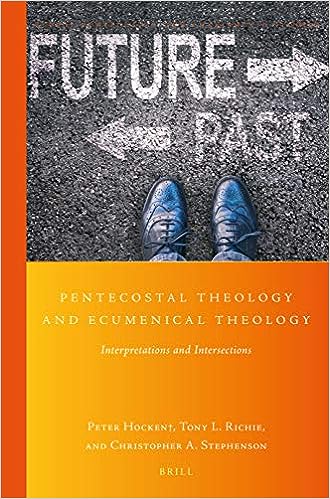Pentecostal Theology and Ecumenical Theology
 Peter Hocken, Tony L. Richie, and Christopher Stephenson, eds., Pentecostal Theology and Ecumenical Theology: Interpretations and Intersections, Global Pentecostal and Charismatic Studies Vol. 34 (Leiden; Boston: Brill, 2019), 368 pages, ISBN 9789004408364.
Peter Hocken, Tony L. Richie, and Christopher Stephenson, eds., Pentecostal Theology and Ecumenical Theology: Interpretations and Intersections, Global Pentecostal and Charismatic Studies Vol. 34 (Leiden; Boston: Brill, 2019), 368 pages, ISBN 9789004408364.
In volume thirty-four of Brill’s Global Pentecostal and Charismatic Studies, editors Peter Hocken, Tony L. Richie, and Christopher Stephenson spearhead a collection of essays discussing varied interpretations and intersections of Pentecostal theology and Ecumenical theology. The editors and authors of the volume come from varied streams in the global Pentecostal/Charismatic movement and represent a collective of like-minded scholars, who’ve not only contributed to Pentecostal/Charismatic theology, but also supported ecumenical dialogues. Peter Hocken, who died before the final release of said volume, was himself an accomplished ecumenist and a Catholic Charismatic (ix).
Cecil M. Robeck has chronicled that early Pentecostal responses to ecumenism were of trepidation and misconception.
In part I, essays were largely descriptive of historical and current Pentecostal interpretations on ecumenism. Notable among the essays is one from Pentecostal historian and ecumenist, Cecil M. Robeck, who chronicled early Pentecostal ideation and response to ecumenism. Robeck pointed out that early responses were of trepidation and misconception—the idea of ecumenism being correlated to the coming of the Antichrist (4). It was only in later years after efforts made by Pentecostal ecumenists like David du Plessis that Pentecostals opened to the viability of ecumenism and ecumenical theology (27).
Cheryl Bridges Johns challenges Pentecostals to envision a future where they have played a key role in the quest for Christian unity.
Let’s explore the intersections between Pentecostal theological perspectives and ecumenical theologies.
Asian Pentecostal, Simon Chan, adds his position to this discussion by proposing that the Holy Spirit’s coming at Pentecost (with the manifestation of tongues speech) inaugurates the Church as a “unity-in-diversity” (273). As a unity-in-diversity, the Pentecostal church can become an avenue for a confluence of traditions. Pentecostals can do this is by developing a more holistic charismatic worship in confluence with sacramental forms of Christianity (280). This confluence allows for the mutual engagement of both Pentecostal/Charismatic worship with liturgical/sacramental forms of Christianity.
Tony Richie calls Pentecostals to look to a future where Christianity is renewed and empowered by the Spirit, not in a homogenous manner, but in a unity-in-diversity.
I highly recommend this volume, Pentecostal Theology and Ecumenical Theology. The editors did a great job of collecting essays that not only inform readers of both theologies’ historical and current interpretations but also of the potential richness in their intersections. Each contributing author brings convincing propositions and evokes further reflection. It may also serve as a prolepsis to the future of Pentecostal/Charismatic scholarship.
Reviewed by Lora Angeline E. Timenia
Publisher’s page: https://brill.com/display/title/39536
Category: In Depth, Summer 2023


